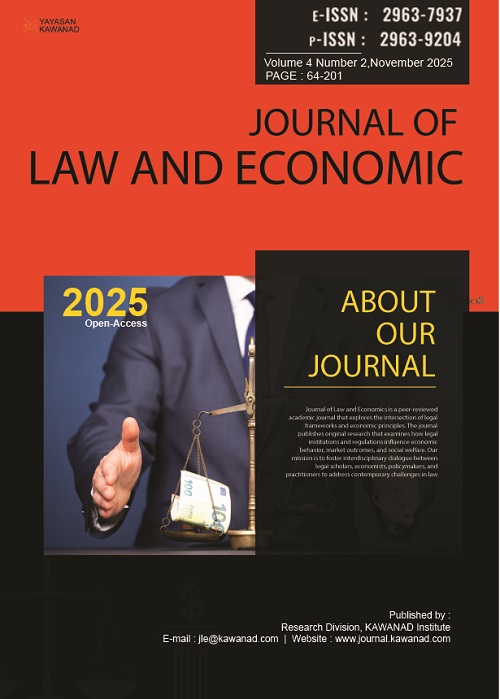TEMPLATE
- masriali@unsyiah.ac.id
- Banda Aceh City, Indonesia
- +6281360650791
Articles
- Home
- Archives
- Vol. 4 No. 2 (2025): NOVEMBER
- Articles
- Home
- Archives
- Vol. 4 No. 2 (2025): NOVEMBER
- Articles
Legal Analysis of Post-Divorce Child Protection Rights (Case Study: Decision No. 3/Pdt.G/2025/PTA.Smd)
- Authors Devani Elisabeth Situngkir , Nurbaiti Nurbaiti
- Affiliations
- Published 2025-11-30
- Section Articles
- DOI https://doi.org/10.56347/jle.v4i2.331
- Issue Vol. 4 No. 2 (2025): NOVEMBER
0
Views
0
Downloads
Altmetrics
Abstract
Rising divorce rates have triggered custody disputes where children's fundamental rights face systematic neglect, generating psychological trauma and legal ambiguity. This research examines post-divorce child protection under Law No. 35 of 2014 on Child Protection, analyzing Decision No. 3/Pdt.G/2025/PTA.Smd as a case study. Two primary questions guide the investigation: first, how courts operationalize the child welfare principle in custody determinations within Decision No. 3/Pdt.G/2025/PTA.Smd; second, how Law No. 35 of 2014 safeguards children's rights amid post-divorce custody conflicts. Employing normative juridical methodology through statutory, conceptual, and case study approaches, the research reveals that Law No. 35 of 2014 establishes child welfare as the paramount consideration in all child-related decisions. The principle addresses physical, psychological, social, and spiritual dimensions to secure optimal development. Decision No. 3/Pdt.G/2025/PTA.Smd demonstrates practical application: the judicial panel awarded custody to the biological mother based on her superior capacity to provide appropriate care environments while preserving paternal visitation rights. The ruling simultaneously mandates financial support obligations, reinforcing continued parental accountability post-divorce. The decision effectively operationalizes child-centered legal frameworks through balanced consideration of caregiving capacity, emotional bonding, and economic responsibility.
Keywords
References
- Badan Pusat Statistik. (2024). Nikah dan cerai menurut provinsi (kejadian), 2024. https://www.bps.go.id/id/statistics-table/3/VkhwVUszTXJPVmQ2ZFRKamNIZG9RMVo2VEdsbVVUMDkjMw==/nikah-dan-cerai-menurut-provinsi.html?year=2024
- Bahrudin, N. (2021). Nikah beda agama dalam kajian hukum dan hak asasi manusia (Vol. 18).
- Bahrudin, N. (2022). 'Urf sebagai dasar ratio decidendi dalam putusan pengadilan agama. Jurnal Kajian Hukum Islam, 7(2), 262–274. https://scholar.google.com/citations?view_op=view_citation&hl=en&user=ISoq9nYAAAAJ&citation_for_view=ISoq9nYAAAAJ:UeHWp8X0CEIC
- Dewan Perwakilan Rakyat Republik Indonesia. (2025). Kajian-public-141. https://berkas.dpr.go.id/puspanlakuu/kajian/kajian-public-141.pdf
- Eleanora, F. N., Ismail, Z., Ahmad, & Lestari, M. P. (2021). Buku ajar hukum perlindungan anak dan perempuan. Madza Media.
- Hasanah, C. A. (2025). Perlindungan hukum dan pertimbangan hakim dalam menentukan hak asuh anak pasca perceraian. Journal of Multidisciplinary Inquiry in Science, 2(1b), 1099–1113. https://doi.org/10.32672/mister.v2i1b.2535
- Mahkamah Agung Republik Indonesia. (2011). Himpunan peraturan perundang-undangan yang berkaitan dengan Kompilasi Hukum Islam serta pengertian dalam pembahasannya. https://perpustakaan.mahkamahagung.go.id/assets/resource/ebook/23.pdf
- Noor, F., Al-Amruzi, M. F., & Hasan, A. (2023). Problematika hak asuh anak pasca putusan perceraian di Pengadilan Agama (Studi kasus nomor 342/PDT.G/2020/PA.MTP Jo Putusan Banding Nomor 32/PDT.G/2020/PTA.BJM Jo Putusan Kasasi Nomor 392 K/AG/2021). Al Qalam: Jurnal Ilmiah Keagamaan dan Kemasyarakatan, 17(6), 4085. https://doi.org/10.35931/aq.v17i6.2808
- Ohoiwutun, Y. A. T., Samosir, S. S. M., & Arimbhi, C. S. A. (2023). Penerapan asas kepentingan terbaik bagi anak korban tindak pidana perkosaan yang melakukan aborsi. Jurnal Hukum, Politik dan Ilmu Sosial (JHPIS), 2, 1261–1231. https://ejurnal.politeknikpratama.ac.id/index.php/jhpis/article/view/1261/1231
- Pemerintah Indonesia. (2014). Undang-Undang Republik Indonesia Nomor 35 Tahun 2014 tentang Perubahan atas Undang-Undang Nomor 23 Tahun 2002 tentang Perlindungan Anak.
- Pengadilan Negeri Tabanan. (2024). Hak asuh anak setelah perceraian. https://pn-tabanan.go.id/berita/artikel/detail/hak-asuh-anak-setelah-perceraian/eddea82ad2755b24c4e168c5fc2ebd40
- Sagita, R., & Suherman, A. (2024). Perlindungan dan kepastian hukum terhadap hak anak pasca perceraian. Jurnal Kajian Hukum dan Kebijakan Publik, 2, 221–229. https://jurnal.kopusindo.com/index.php/jkhkp
- Sari, D. N. (2014). Analisis perlindungan hak asuh anak pasca perceraian berdasarkan Undang-Undang Nomor 35 Tahun 2014 tentang Perlindungan Anak [Undergraduate thesis, Universitas Islam Kalimantan MAB]. Eprints Uniska. https://eprints.uniska-bjm.ac.id/22659/
- Siregar, D., Sitepu, K., Darma, M., Na'im, K., Tarigan, M. T. U., Razali, R., & Harahap, F. S. (2023). Studi hukum tentang tingkat perceraian dan efeknya terhadap anak. Jurnal Derma Pengabdian Dosen Perguruan Tinggi (Jurnal DEPUTI), 3(2), 178–185. https://doi.org/10.54123/deputi.v3i2.276
- Tarmizi, Pradiba, Y., & Usman, K. (2023). Hak asuh anak (hadhanah) pasca perceraian serta akibat hukumnya. Jurnal Ilmu Hukum Pengayoman.
Author Biographies


Similar Articles
Discover other articles with topics similar to what you're currently reading. Find more references and expand your knowledge base.

More Similar Articles
Personal Data Security Violations in East Jakarta...
Khairul Alwan Albaldan, Nin Yasmine Lisasih
Vol. 4 No. 2 (2025): NOVEMBERLegal Protection Analysis of Personal Data Breaches in...
Dewi Noviyanti, Yuniwati, Suratno
Vol. 4 No. 1 (2025): MAYJuridical Review of Human Trafficking as a Transnational...
Rini T Simangunsong , Dina M Situmeang
Vol. 4 No. 1 (2025): MAYThe Doctrine of Unlawful Acts in E-Commerce Consumer...
Serlita Ruben Pendang
Vol. 4 No. 2 (2025): NOVEMBER













